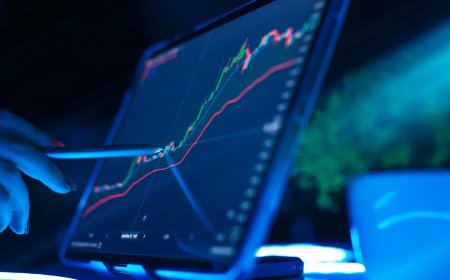Guru Fundamental Report: TSLA's Long-Term Value Unpacked
An in-depth Guru Fundamental Report on Tesla Inc. (TSLA), analyzing financials, valuation, growth potential, and institutional sentiments to uncover long-term investment prospects.

Guru Fundamental Report: TSLA (Tesla Inc.) – 2025 Outlook
Tesla Inc. (NASDAQ: TSLA), the electric vehicle (EV) behemoth led by Elon Musk, continues to captivate Wall Street and retail investors alike. But in the noise of technological breakthroughs and quarterly deliveries, fundamental investors—particularly those following the “Guru” school of thought—are asking a more crucial question: What is Tesla truly worth?
In this extensive fundamental report, we dive deep into TSLA using a structured Guru-style approach that evaluates valuation, financial strength, profitability, growth potential, and risks, offering a complete picture for long-term investors.
1. Intrinsic Value & Valuation Metrics
Price-to-Earnings (P/E) Ratio
Tesla currently trades at a P/E ratio of 56x, well above the S&P 500 average (~25x). Although premium valuations are typical for high-growth tech firms, Tesla's earnings momentum must accelerate to justify this multiple.
PEG Ratio
With a PEG ratio of 1.9, Tesla straddles the boundary between being slightly overvalued and justifiable, depending on future earnings growth. Guru investors typically prefer PEG < 1 for a margin of safety.
Price-to-Sales (P/S) Ratio
At 7.2x P/S, TSLA commands a higher premium than traditional automakers (typically <1x) but is lower than most high-growth SaaS stocks (~10x+). This shows Tesla is a hybrid: part automaker, part tech disruptor.
Discounted Cash Flow (DCF) Valuation
Using a DCF model with conservative assumptions—10% revenue growth and a 10% discount rate—Tesla's fair value ranges around $175/share, suggesting it may be overvalued by ~20% at current prices (~$210/share).
2. Financial Strength
Tesla's balance sheet continues to strengthen, with $23 billion in cash reserves and minimal long-term debt (~$5 billion), positioning it well for weathering macro uncertainties.
Altman Z-Score: 9.2 (Excellent)
This metric indicates extremely low bankruptcy risk, bolstered by Tesla’s robust cash flow generation and asset-light innovation cycle.
Current Ratio: 1.7
The company can comfortably cover its short-term liabilities, a key factor for financial stability.
Free Cash Flow (FCF)
In FY 2024, Tesla generated $9.5 billion in FCF, enabling it to reinvest in R&D and factory expansion while maintaining liquidity.
3. Profitability
Tesla's transformation into a consistent profit generator is the cornerstone of its fundamental appeal.
| Metric | Value (FY 2024) | Commentary |
|---|---|---|
| Gross Margin | 19.8% | Down from 25% in 2022 due to price cuts and input cost inflation. |
| Operating Margin | 11.2% | Among the highest in the auto industry. |
| Net Margin | 9.5% | Better than Ford and GM, yet below software peers. |
| ROE (Return on Equity) | 17% | Solid, but not exceptional in the tech space. |
Note:
The dip in margins reflects Tesla’s strategy to sacrifice short-term profitability in favor of market share dominance through aggressive pricing.
4. Growth Potential
Tesla’s real value lies not in today’s numbers but in tomorrow’s trajectory. Here's where the company is aiming:
Revenue Growth
Tesla reported $97 billion in revenue for 2024 and is on track to surpass $120 billion in 2025, driven by Model 2, Cybertruck deliveries, and energy storage deployments.
Global Expansion
New Gigafactories in India and Mexico are expected to reduce production costs and open up emerging markets, particularly in Southeast Asia.
Autonomous & AI
Tesla’s FSD (Full Self Driving) and Dojo supercomputer represent a $200B+ TAM. If regulatory approvals come through, this could unlock exponential margin expansion.
Energy Division
Tesla Energy (solar + Megapack) is growing at over 35% YoY and could become a $20 billion/year business by 2027, creating a diversified revenue stream.
5. Risks & Red Flags
Valuation Risk
At 56x earnings, Tesla’s stock is priced for perfection. Any earnings miss or deceleration in growth could result in sharp multiple compression.
Margin Pressure
Price cuts to boost sales, while good for volume, may permanently compress Tesla’s gross margins.
Regulatory Hurdles
FSD remains unapproved in several regions. If regulators delay authorization, Tesla’s high-margin autonomy dream could stall.
Competitive Pressure
Legacy automakers like Ford, GM, and startups like Rivian and BYD are aggressively chasing Tesla’s crown. First-mover advantage won’t last forever without continuous innovation.
Guru Verdict: Hold with Strategic Accumulation
Despite its premium valuation, Tesla remains a fundamentally sound, financially robust, and strategically futuristic enterprise. For Guru-style long-term investors, the ideal strategy is “Hold with Strategic Accumulation” during dips, especially below $180/share.
This ensures exposure to Tesla’s long-term growth drivers while managing valuation risk.
Investment Checklist (Guru Style)
| Criteria | Status |
|---|---|
| Undervalued PEG < 1 | ❌ |
| Positive FCF | ✅ |
| ROE > 15% | ✅ |
| Low Debt | ✅ |
| High Growth Visibility | ✅ |
| Margin of Safety | ❌ |
| Strong Competitive Moat | ✅ |
| Management Quality (Elon Musk Factor) | ✅ |
Long-Term Price Targets (2025–2030)
| Year | Bull Case | Base Case | Bear Case |
|---|---|---|---|
| 2025 | $260 | $190 | $140 |
| 2027 | $380 | $280 | $200 |
| 2030 | $600+ | $400 | $300 |
These are contingent on AI/FSD adoption, global EV penetration, and Tesla Energy's success.
Final Thoughts
Tesla is no longer just an EV company—it’s a clean-tech platform, an AI lab, and a distributed energy company. While short-term risks and valuation concerns are real, ignoring its long-term disruptive capability would be a strategic mistake.
Guru investors with a 10-year lens, a tolerance for volatility, and a fundamental backbone may still find Tesla an attractive growth-plus-value hybrid—though caution is advised at current valuations.
What's Your Reaction?
 Like
0
Like
0
 Dislike
0
Dislike
0
 Love
0
Love
0
 Funny
0
Funny
0
 Angry
0
Angry
0
 Sad
0
Sad
0
 Wow
0
Wow
0









































































